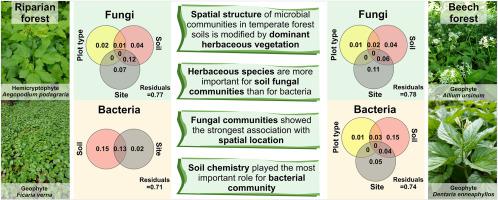当前位置:
X-MOL 学术
›
Soil Biol. Biochem.
›
论文详情
Our official English website, www.x-mol.net, welcomes your feedback! (Note: you will need to create a separate account there.)
Dominant herbaceous plants contribute to the spatial heterogeneity of beech and riparian forest soils by influencing fungal and bacterial diversity
Soil Biology and Biochemistry ( IF 9.7 ) Pub Date : 2024-03-19 , DOI: 10.1016/j.soilbio.2024.109405 Szymon Zubek , Katarzyna Rożek , Dominika Chmolowska , Iñaki Odriozola , Tomáš Větrovský , Kaja Skubała , Priscila Thiago Dobler , Anna M. Stefanowicz , Małgorzata Stanek , Aleksandra Orzechowska , Petr Kohout , Petr Baldrian
Soil Biology and Biochemistry ( IF 9.7 ) Pub Date : 2024-03-19 , DOI: 10.1016/j.soilbio.2024.109405 Szymon Zubek , Katarzyna Rożek , Dominika Chmolowska , Iñaki Odriozola , Tomáš Větrovský , Kaja Skubała , Priscila Thiago Dobler , Anna M. Stefanowicz , Małgorzata Stanek , Aleksandra Orzechowska , Petr Kohout , Petr Baldrian

|
Understanding of factors that shape diversity patterns in forest ecosystems is a main challenge in forest ecology and management practices. Although herbaceous plants are known to contribute to the maintenance of the structure and function of temperate forests, their impact on fungal and bacterial communities in soils is largely unknown. Therefore, we conducted a comparative study of soil fungal and bacterial diversity in two Central European deciduous forests, focusing on plots with dominant herbaceous species of contrasting morphology, phenology, reproduction, and ecology, including and in a beech forest, as well as and in a riparian forest. Plots with a mixture of herbaceous species and without plant cover were also studied. In both forests, fungal communities showed the strongest association with spatial location, part of which was explained by between-site variability in soil chemistry and was also influenced by herbaceous vegetation. The community composition of saprotrophic fungi depended on the presence and type of herbaceous vegetation in both forests. In addition, herbaceous plants affected the composition of arbuscular mycorrhizal fungi community in the beech forest, while in the riparian forest they affected endophytes and plant pathogens. For bacteria, soil chemistry played the most important role. Our results showed that dominant herbaceous vegetation is one of the drivers shaping microbial community composition, contributing to spatial heterogeneity of forest sites. Given that herbaceous species, especially those forming monospecific patches, affect the soil biotic properties in temperate forests, they should be included in forest management practices.
中文翻译:

优势草本植物通过影响真菌和细菌多样性,导致山毛榉和河岸森林土壤的空间异质性
了解塑造森林生态系统多样性模式的因素是森林生态和管理实践的主要挑战。尽管已知草本植物有助于维持温带森林的结构和功能,但它们对土壤中真菌和细菌群落的影响在很大程度上尚不清楚。因此,我们对两个中欧落叶林的土壤真菌和细菌多样性进行了比较研究,重点关注具有对比形态、物候、繁殖和生态学的优势草本物种的地块,包括山毛榉林和山毛榉林。河岸森林还研究了混合草本物种且没有植物覆盖的地块。在这两个森林中,真菌群落显示出与空间位置最强的关联,部分原因是土壤化学的不同地点之间的变化,并且还受到草本植被的影响。腐生真菌的群落组成取决于两个森林中草本植被的存在和类型。此外,草本植物影响山毛榉林中丛枝菌根真菌群落的组成,而在河岸林中则影响内生菌和植物病原体。对于细菌来说,土壤化学起着最重要的作用。我们的结果表明,优势草本植被是塑造微生物群落组成的驱动因素之一,有助于森林地点的空间异质性。鉴于草本物种,特别是那些形成单一斑块的草本物种,影响温带森林的土壤生物特性,因此应将它们纳入森林管理实践中。
更新日期:2024-03-19
中文翻译:

优势草本植物通过影响真菌和细菌多样性,导致山毛榉和河岸森林土壤的空间异质性
了解塑造森林生态系统多样性模式的因素是森林生态和管理实践的主要挑战。尽管已知草本植物有助于维持温带森林的结构和功能,但它们对土壤中真菌和细菌群落的影响在很大程度上尚不清楚。因此,我们对两个中欧落叶林的土壤真菌和细菌多样性进行了比较研究,重点关注具有对比形态、物候、繁殖和生态学的优势草本物种的地块,包括山毛榉林和山毛榉林。河岸森林还研究了混合草本物种且没有植物覆盖的地块。在这两个森林中,真菌群落显示出与空间位置最强的关联,部分原因是土壤化学的不同地点之间的变化,并且还受到草本植被的影响。腐生真菌的群落组成取决于两个森林中草本植被的存在和类型。此外,草本植物影响山毛榉林中丛枝菌根真菌群落的组成,而在河岸林中则影响内生菌和植物病原体。对于细菌来说,土壤化学起着最重要的作用。我们的结果表明,优势草本植被是塑造微生物群落组成的驱动因素之一,有助于森林地点的空间异质性。鉴于草本物种,特别是那些形成单一斑块的草本物种,影响温带森林的土壤生物特性,因此应将它们纳入森林管理实践中。



























 京公网安备 11010802027423号
京公网安备 11010802027423号